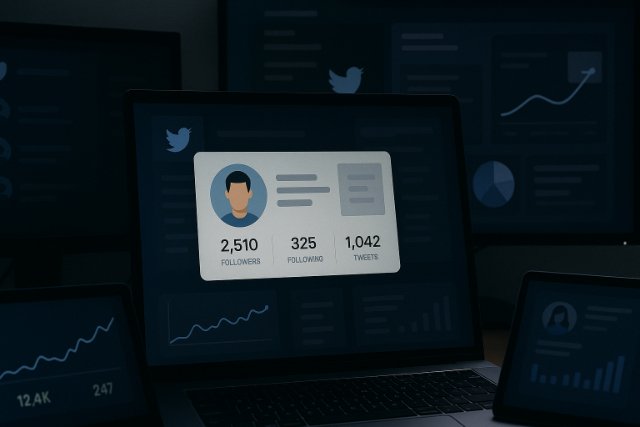Introduction
When Twitter transformed into X under Elon Musk’s ownership, the platform began restricting unlogged access to tweets and profiles. Features once open to anyone now often trigger a login prompt. For users who wish to view public Twitter/X profiles anonymously without revealing their identity or logging in twitter profile viewers emerged as indispensable tools.
These tools bridge the gap between public data access and privacy. Whether you’re a digital marketer benchmarking competitors, a journalist conducting open-source research, or a casual user who prefers not to sign in, a profile viewer allows effortless browsing of public tweets, bios, and engagement data.
This comprehensive guide dissects how twitter profile viewers work, highlights leading tools in 2025, and clarifies the myths, legal boundaries, and ethical responsibilities attached to using them. By the end, you’ll understand how to navigate X intelligently and safely, while respecting the privacy and data policies that govern online transparency.
Understand How a Twitter Profile Viewer Works
A twitter profile viewer functions as an independent interface or application that fetches publicly available Twitter/X data without requiring user authentication. Essentially, it acts as a proxy layer between your browser and Twitter’s servers. Instead of loading the original Twitter interface which embeds trackers, ads, and login prompts the viewer retrieves and displays clean, minimal versions of tweets and profiles.
When you input a username or keyword, the viewer sends a request to Twitter’s publicly visible endpoints or cached databases. The retrieved HTML or JSON data is then rendered in a simplified layout. This is similar to how search engines index public pages, but limited to individual profiles or timelines. Viewers thus provide read-only access to public content, ensuring no write or interaction permissions are used.
Technically, viewers use one or a combination of the following methods:
- Scraping: Extracting publicly visible content via automated parsing.
- API calls: Accessing authorized data using limited API keys (for legitimate platforms).
- Caching / Mirroring: Storing previous snapshots of public tweets to reduce load.
- Proxy routing: Using intermediary servers to anonymize the viewer’s location.
Together, these enable fast, anonymous viewing while minimizing exposure to Twitter’s session or cookie tracking.
What Kinds of Data Can You See Through a Twitter Profile Viewer
Depending on the viewer, the accessible data can range from simple tweets to full engagement analytics.
The core entities include:
- Tweets and Replies: The main timeline of an account, including text, hashtags, media, and links.
- Profile Metadata: Username, display name, join date, follower/following counts, and verification status.
- Media Gallery: Photos, GIFs, and videos uploaded publicly.
- Engagement Metrics: Likes, retweets, quotes, replies, and in some tools, estimated impressions.
- Hashtag or Keyword Analytics: Tools like TweetBinder analyze frequency, contributors, and sentiment.
| Data Category | Example | Available In | Purpose |
| Tweets Feed | @NASA recent posts | Nitter, TwitterViewer | Read-only viewing |
| Profile Metadata | Bio, followers | All tools | User insights |
| Engagement Metrics | Likes, retweets | TweetBinder, SocialWalls | Competitive benchmarking |
| Media Downloads | Images, videos | Nitter | Archival / research |
| Hashtag Analytics | #AI trends | TweetBinder | Marketing tracking |
These features make profile viewers highly versatile for social analysis and content exploration without breaching account privacy.
Clarify Whether You Can See Who Visited Your Twitter Profile

One of the most common misconceptions on the internet is that you can use a twitter profile viewer to see who viewed your profile. This is categorically false.
Twitter’s infrastructure, both pre- and post-rebrand to X, never tracked identifiable visitor data for public profiles. The only related metric “Profile visits” is cumulative and anonymous. This ensures compliance with data protection regulations (GDPR, CCPA) and preserves user privacy.
Despite this, thousands of fake browser extensions and mobile apps claim to reveal “who viewed your profile.” These are scams designed to harvest credentials or install malware.
Understand What Twitter Officially Provides
The official Twitter Analytics platform (analytics.twitter.com) gives creators and businesses visibility into performance metrics such as:
- Tweet impressions
- Profile visits
- Mentions
- Follower growth
- Engagement rates
However, all this data is aggregated you’ll never see a named list of visitors. The X Analytics dashboard (2025) continues this structure, providing top tweets, audience demographics, and engagement patterns, but not personal identities.
For advertisers, X Ads Manager adds more sophisticated insights like conversion tracking and audience reach, yet these also remain anonymized.
In contrast, profile viewers simply mirror public-facing data, not internal analytics. Understanding this difference helps users distinguish between analytics and viewer myths.
Avoid Falling for “Who Viewed My Profile” Claims
Fraudulent apps or sites that ask you to “sign in to reveal visitors” exploit curiosity. These platforms often imitate Twitter’s design, prompting users to authorize malicious OAuth requests. Once credentials are entered, attackers can post spam, steal tokens, or lock you out of your account.
Always verify the tool’s authenticity through:
- Community reviews (e.g., Reddit’s r/OSINT or r/Privacy)
- Open-source repositories on GitHub
- Transparent privacy policies
No legitimate twitter profile viewer will ever request login credentials or offer individual visitor data. If it does, treat it as a red flag.
Explore the Best Twitter Profile Viewers in 2025

By 2025, the twitter ecosystem has evolved, with some tools disappearing due to API restrictions and others thriving through open-source collaboration. The best tools today balance privacy, transparency, and reliability.
| Tool | Type | Highlights | Best For |
| Nitter (Forked Instances) | Open-source | Lightweight, RSS support, privacy-first | Anonymous viewing |
| TweetBinder | Commercial analytics | Hashtag tracking, CSV export | Marketing analytics |
| TwitterViewer.net | Free browser tool | Clean UI, fast, no login | Casual viewing |
| SocialWalls.io | Enterprise dashboard | Campaign analytics, live walls | Agencies / brands |
| Snaplytics | Multi-platform | X + TikTok + Instagram analytics | Influencer tracking |
How Nitter Works and Its Current Status
Nitter remains the cornerstone of open, anonymous Twitter browsing. It’s an alternative front-end, meaning it re-renders Twitter’s public pages with stripped-down HTML and without JavaScript trackers.
After Twitter tightened guest restrictions in 2023, Nitter’s main instance (nitter.net) went offline. However, the open-source community quickly created independent forks hosted across decentralized networks. Each instance functions independently, fetching cached data through proxy APIs or scraping pipelines.
By 2025, dozens of Nitter mirrors such as nitter.poast.org or nitter.freedit.eu remain functional, supported by privacy communities and OSINT researchers. Its benefits include:
- Ad-free, cookie-free browsing
- RSS feeds for any Twitter account
- Optional self-hosting for teams or journalists
This resilience cements Nitter’s place as the most trusted anonymous twitter profile viewer available today.
Popular Web Tools: TweetBinder, Snaplytics, and Others
TweetBinder stands out as a robust analytics platform, providing in-depth hashtag reports, influencer rankings, and engagement heatmaps. It uses official API access to deliver accurate metrics and supports CSV exports for campaign analysis.
Snaplytics Social extends this to multi-platform coverage combining data from X, Instagram, and TikTok which is crucial for brands managing cross-network influence.
Meanwhile, SocialWalls.io integrates multiple accounts into real-time social walls, ideal for events or live coverage dashboards.
For everyday users seeking simplicity, TwitterViewer.net remains a lightweight, web-based viewer where you can browse tweets instantly no login, no data tracking, and no complex dashboards.
Follow the Steps to Use a Twitter Profile Viewer
Most twitter profile viewers are plug-and-play tools that require no software or registration. Here’s a typical workflow:
- Visit a verified viewer (e.g., Nitter or TwitterViewer.net).
- Type the username or handle (for example, @NASA).
- View public tweets, images, and replies instantly.
- Use additional analytics (if available) to export data or generate summaries.
This process eliminates the need for Twitter accounts, cookies, or logged sessions.
Bypass Region Restrictions or Login Walls
Twitter/X sometimes restricts content visibility based on region or session limits. To navigate these, many viewers deploy proxy networks that reroute requests through alternate IPs.
Users can also rely on browser extensions that automatically redirect Twitter links to a Nitter instance. However, caution is essential unverified extensions can compromise security. The safest approach is to use community-verified instances listed on GitHub repositories like zedeus/nitter or community-nitter-lists.
Comply With Legal, Ethical, and Security Standards
Responsible use is critical. Viewing public tweets is legal, but mass scraping or circumventing paywalls may violate platform terms or national laws.
Legal frameworks such as the EU’s GDPR, California’s CCPA, and Twitter’s Developer Agreement govern how data can be collected, stored, or redistributed. For individual users conducting small-scale research, the key rule is:
Access only publicly visible data and avoid automated scraping at scale.
Understand Platform Policies and Terms
Twitter/X differentiates between public consumption (viewing) and automated collection (scraping). Unauthorized automation breaches Section 1.4 of the Developer Policy.
However, legitimate viewers like TweetBinder maintain compliance through licensed APIs. Nitter, while not officially sanctioned, operates within the “fair use” boundary since it doesn’t expose private content or require authentication. The distinction lies in intent: transparency and privacy enhancement are acceptable; data harvesting or commercial resale is not.
Recognize Privacy Risks and Verify Tool Safety
Security should always come first. Fake “profile viewers” can:
- Steal credentials via OAuth phishing.
- Install tracking cookies or malware.
- Sell browsing patterns to advertisers.
To stay safe:
- Use HTTPS-only tools.
- Verify open-source code availability.
- Avoid mobile apps that ask for permissions beyond network access.
Transparency is a strong safety indicator. If a viewer publicly lists its maintainers or GitHub repository, it’s generally trustworthy.
Interpret Profile Metrics and Analytics in Context
Many users confuse viewer insights with Twitter’s internal analytics. The difference lies in data ownership and accuracy.
Twitter Analytics (accessible only to account owners) uses first-party data: impressions, reach, engagement, link clicks, and demographic breakdowns. Profile viewers, on the other hand, rely on estimated metrics derived from visible data e.g., likes, retweets, follower counts without backend confirmation.
Understand the “Profile Visits” Metric in Twitter Analytics
The “Profile visits” metric indicates how often your profile was opened by others within a time frame. It’s a useful measure of brand interest, especially for creators or businesses monitoring audience engagement. However, it remains aggregated and anonymous no names or profiles are ever attached.
For marketers, this metric complements Tweet impressions and Engagement rate to gauge campaign effectiveness. But it is only accessible for your own account not others’.
Additional Metrics Shown by Viewer Tools
Third-party viewers estimate metrics such as:
- Follower growth over time
- Most active tweeting hours
- Average engagement per tweet
- Hashtag frequency analysis
These estimates help compare competitors or identify influencers within a niche. Tools like TweetBinder and SocialWalls visualize such data via interactive dashboards, providing contextual analytics that augment not replace official X data.
Apply Advanced Use Cases and Explore Alternatives
Beyond casual browsing, twitter profile viewers have deep professional applications across OSINT (Open Source Intelligence), brand monitoring, and digital archiving.
Investigators and researchers often use viewers as entry points to collect publicly available social data before integrating it into structured tools for correlation and analysis.
Use Social Media Monitoring or OSINT Platforms
For example, journalists tracking disinformation networks can pair Nitter with tools like:
- Maltego for relational mapping of accounts.
- SpiderFoot for metadata correlation.
- Archive.today for capturing tweet evidence.
Marketing teams, conversely, integrate TweetBinder or Hootsuite Analytics for campaign tracking and audience measurement. These workflows expand a simple viewer into a data intelligence pipeline.
When to Rely on Official APIs or Data Providers
When accuracy, compliance, and scalability are priorities such as in enterprise analytics or academic research the official X API (v2/Enterprise) remains superior.
The API allows structured access to endpoints like:
- /tweets — retrieve tweet text, IDs, and metrics
- /users — fetch account data
- /engagements — analyze impressions and likes
Licensed API usage ensures full adherence to Twitter’s data policies and avoids scraping restrictions. Many professional tools (e.g., Brandwatch, Meltwater) operate this way to ensure long-term stability.
Debunk Common Myths and Misconceptions
Despite growing awareness, misinformation about twitter profile viewers persists. Let’s clarify the top myths.
“I Saw Someone Viewed Me” Is That Real?
No viewer official or third-party provides identifiable visitor data. Any site claiming to show “viewers” or “stalkers” fabricates results. These lists are generated randomly or by scraping your followers. Twitter/X has never exposed personal visitor tracking to maintain privacy compliance under global regulations.
Claims of Private Account Access Reality Check
Viewers cannot bypass account privacy settings. If a profile is set to “protected,” even APIs return “unauthorized.” Any service claiming otherwise is operating illegally or deceptively.
Ethical use respects boundaries: view what’s public, and avoid tools that encourage unauthorized access. Doing so not only protects you legally but supports responsible data transparency.
Conclusion
The twitter profile viewer embodies the intersection of privacy, accessibility, and transparency in the modern social web. As Twitter continues its evolution into X, the ability to view public content without logging in remains vital for research, marketing, and everyday curiosity.
By choosing legitimate tools like Nitter or TweetBinder, users can safely explore social data without compromising privacy or breaching platform rules. The key lies in informed usage understanding limitations, respecting ethics, and verifying tool safety.
As data ecosystems tighten, responsible public access becomes a cornerstone of digital literacy. A well-chosen twitter profile viewer doesn’t just offer anonymity; it empowers smarter, safer, and more transparent interaction with online information.
Explore more insightful and valuable content on our blog VeoTag.com! Stay updated with helpful tips, expert advice, and in-depth articles that enhance your knowledge.
Rad Also:
gramhir.pro: What It Is, What It Isn’t & How to Use It (2025 Guide)
Olympus Scanlation: Fan Translations Explained
Ontpress Freshupdates: How It Works, Features
Twitter Viewer: How to See Tweets, Profiles & Analytics
5stars stocks.com: In-Depth Review, How It Works
FAQ’s
No. Neither Twitter nor viewer tools reveal visitor identities. Only aggregated metrics like profile visits exist.
Yes, if you view only public data. Accessing private content or using automated scraping violates platform terms.
No. Protected tweets are inaccessible to both humans and bots unless you’re an approved follower.
No. Use open-source or community-verified tools. Avoid those asking for login or excessive permissions.
Yes, through decentralized forks and mirrors managed by the open-source community.
Viewers display public, external data; Twitter Analytics shows your internal performance metrics.
Yes, platforms like TweetBinder and SocialWalls allow CSV exports for hashtag or tweet datasets.
Third-party viewers may temporarily fail or reduce functionality until updated to new data endpoints.

